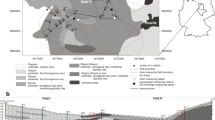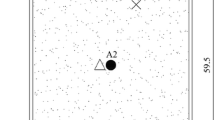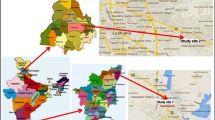Abstract
Purpose
Golf courses are constructed from artificial layers on top of natural soil as the goal is to rapidly drain excess water through the soil profile using subsurface tile drainage system. Golf turf is one of the most intensively managed systems due to the high use of fertilizer and irrigation. Leaching and runoff of nitrogen (N) from turf can pollute surface- and groundwaters. Our objective was to understand the fate of water and nitrate–N in constructed golf course turf.
Materials and methods
We conducted a modeling study for system 1 with tile drainage and artificial soil layers and system 2 with a natural soil profile using HYDRUS 2D. Experimental data from a planned golf course in Istria, Croatia for natural soil were used. Artificial layers were constructed according to United States Golf Association (USGA) recommendations. Urea was used as the fertilizer N source at three application rates (50, 75, and 100 kg ha−1).
Results and discussion
Water flow modeling showed a large amount of tile drainage outflow in system 1, where tile drains aided in lowering the pressure head in the soil above the tile drains. In system 2, low permeability of the natural soil and lack of drainage resulted in lower pressure head in the topsoil with surface runoff during high rainfall. Results of solute simulations using HYDRUS 2D revealed that at 100 kg ha−1 scenario, 66 % of ammonium–N, and 39 % of nitrate–N were leached through tile drains rather than infiltrate into the subsoil. The distribution of the nitrate–N was predominantly influenced by the highly permeable layers and tile drainage system. However, in the absence of drainage, modeling revealed that a large amount of nitrate–N can reach bottom of the soil profile and thus leach into groundwater.
Conclusions
The modeling study revealed that using a USGA recommendation for golf course construction can reduce nitrate–N leaching into subsoil and consequently groundwater. The presence of tile drains provided a rapid conduit for transmission of water and nutrients (N species in this specific case), thus limiting infiltration of water and associated solutes into subsoil layers. Subsurface drainage systems are typically installed only on golf greens and not on the entire golf course area, while fertilizers are applied across entire golf course, which can lead to greater leaching of nitrate–N.








Similar content being viewed by others
References
Beard JB (1982) Turf management for golf courses. A Publication of the United States Golf Association. Macmillan, New York
Blonquist JM Jr, Jones SB, Robinson DA (2006) Precise irrigation scheduling for turfgrass using a subsurface electromagnetic soil moisture sensor. Agric Water Manag 84:153–165. doi:10.1016/j.agwat.2006.01.014
Bolado-Rodriguez S, Alonso-Gaite A, Álvarez-Benedi J (2005) Characterization of nitrogen transformations, sorption and volatilization processes in urea fertilized soils. Vadose Zone J 4:329–336
Brown KW (1982) Nitrogen source effect on nitrate and ammonium leaching and runoff from greens. Agron J 74:947–950
Brown KW, Duble RL, Thomas JC (1977) Influence of management and season on fate of N applied to golf greens. Agron J 69:667–671
Dane JH, Hopmans JW (2002) Water retention and storage: laboratory. In: Methods of soil analysis. Part 4. Physical methods, Third Edition. SSSA, Madison, WI
EPA (2010) Golf course adjustments factors for modifying estimated drinking water concentrations and estimated environmental concentrations generated by tier I (FIRST) and tier II (PRZM/EXAMS) models. US Environmental Protection Agency. www.epa.gov/oppefed1/models/water/golf_course_adjustment_factors.htm. Accessed 22/02/10
Fayer MJ, Rockhold ML, Campbell MD (1992) Hydrologic modeling of protective barriers: comparison of field data and simulation results. Soil Sci Soc Am J 56:690–700
Feddes RA, Kowalik PJ, Zaradny H (1978) Simulation of field water use and crop yield. Wiley, New York
Filipović V, Kodešová R, Petošić D (2013) Experimental and mathematical modeling of water regime and nitrate dynamics on zero tension plate lysimeters in soil influenced by high groundwater table. Nutr Cycl Agroecosyst 95:23–42
Gee GW, Or D (2002) Particle size analysis. In: Methods of soil analysis. Part 4. Physical methods, SSSA, Madison, WI, pp 255–293
Green Section Staff USGA (1960) Specifications for a method of putting green construction. USGA J Turf Manag 13(3):24–28
Hanson BR, Šimůnek J, Hopmans JW (2006) Evaluation of urea–ammonium–nitrate fertigation with drip irrigation using numerical modeling. Agric Water Manag 86:102–113
Keskin M, Dodd RB, Han YJ, Khalilian A (2004) Assessing nitrogen content of golf course turfgrass clippings using spectral reflectance. Appl Eng Agric 20:851–860
Klute A, Dirksen C (1986) Hydraulic conductivity and diffusivity: laboratory methods. In: Methods of soil analysis. Part 1. Physical and mineralogical methods. Agronomy Monograph no. 9. ASA-SSSA, Madison, USA
Lewis MA, Boustany RG, Dantin DD, Quarles RL, Moore JC, Stanley RS (2002) Effects of a coastal golf complex on water quality, periphyton and seagrass. Ecotoxicol Environ Saf 53:154–162
Liu H, Hull RJ, Duff DT (1993) Chapter 77: comparing cultivars of three cool-season turf grasses for nitrate uptake kinetics and nitrogen recovery in the field. In: Carrow RN, Christians NE, Shearmans RC (eds) International turfgrass society research Journal 7. Intertec Publishing Corp, Florida
Mancino CF, Troll J (1990) Nitrate and ammonium leaching losses from N fertilizers applied to ‘Penncross’ creeping bentgrass. Hortic Sci 25:194–196
Marshall SB, Mullen MD, Cabrera ML, Wood CW, Braun LC, Guertal EA (2001) Nitrogen budget for fescue pastures fertilized with broiler litter in major land resource areas of the southeastern US. Nutr Cycl Agroecosyst 59:75–83
McCoy EL, McCoy KR (2009) Simulation of putting-green soil water dynamics: implications for turfgrass water use. Agric Water Manag 96:405–414
Monteith JL (1981) Evaporation and surface temperature. Q J R Meteorol Soc 107:1–27
Morton TG, Gold AJ, Sullivan WM (1988) Influence of overwatering and fertilization on nitrogen losses from home lawns. J Environ Qual 17:124–130
Mualem Y (1976) A new model for predicting the hydraulic conductivity of unsaturated porous media. Water Resour Res 12:513–522
Paré K, Chantigny MH, Carey K, Dionne J (2008) Leaching of mineral and organic nitrogen from putting green profiles supporting various turfgrasses. Crop Sci 48:2010–2016
Petrovic AM (1990) The fate of nitrogenous fertilizers applied to turfgrass. J Environ Qual 19:124–130
Quiroga-Garza HM, Picchioni GA, Remmenga MD (2001) Bermudagrass fertilized with slow-release nitrogen sources. I. Nitrogen uptake and potential leaching losses. J Environ Qual 30:440–448
Ravikumar V, Vijayakumar G, Šimůnek J, Chellamuthu S, Santhi R, Appavu K (2011) Evaluation of fertigation scheduling for sugarcane using a vadose zone flow and transport model. Agric Water Manag 98:1400–1431
Shuman LM, Smith AE, Bridges DC (2000) Potential movement of nutrients and pesticides following application to golf courses. In: Clark JM, Kenna MP (eds) Fate and management of turfgrass chemicals, 743ACS Symposium Series, pp 78–93
Šimůnek J, Šejna M, van Genuchten MTh (1999) The HYDRUS-2D software package for simulating twodimensonal movement of water, heat, and multiple solutes in variable saturated media. Version 2.0, IGWMC-TPS-53. International Ground Water Modeling Center, Colorado School of Mines, Golden, Colorado. Technical Manual. PC Progress, Prague
Šimůnek J, van Genuchten MTh, Šejna M (2006) The HYDRUS software package for simulating two- and three-dimensional movement of water, heat, and multiple solutes in variably saturated media. Version 1.0
Starrett SK, Christians NE, Austin TA (1995) Fate of amended urea in turfgrass biosystems. Commun Soil Sci Plant Anal 26:1595–1606
Tanner RA, Gange AC (2005) Effects of golf courses on local biodiversity. Landsc Urban Plan 71:137–146
USGA Green Section Staff (2004) USGA Recommendations for a method of putting green construction. Available online at http://www.usga.org/turf/course_construction/green_articles/USGA_Recommendations_For_a_Method_of_Putting_Green_Construction.pdf
van Genuchten MT (1980) A closed form equation for predicting the hydraulic conductivity of unsaturated soils. Soil Sci Soc Am J 44:892–1037
Wong JWC, Chan CWY, Cheung KC (1998) Nitrogen and phosphorus leaching from fertilizer applied on golf course: lysimeter study. Water Air Soil Pollut 107:335–345
Acknowledgments
This study was partly supported by the European Union MC-IOF Scholarship (PIOF-GA-2012-330669). The authors are very grateful to Paul Damon from the University of Western Australia for comments and text improvement.
Author information
Authors and Affiliations
Corresponding author
Additional information
Responsible editor: Przemysław Charzyński
Rights and permissions
About this article
Cite this article
Filipović, V., Toor, G.S., Ondrašek, G. et al. Modeling water flow and nitrate–nitrogen transport on golf course under turfgrass. J Soils Sediments 15, 1847–1859 (2015). https://doi.org/10.1007/s11368-014-0980-7
Received:
Accepted:
Published:
Issue Date:
DOI: https://doi.org/10.1007/s11368-014-0980-7




